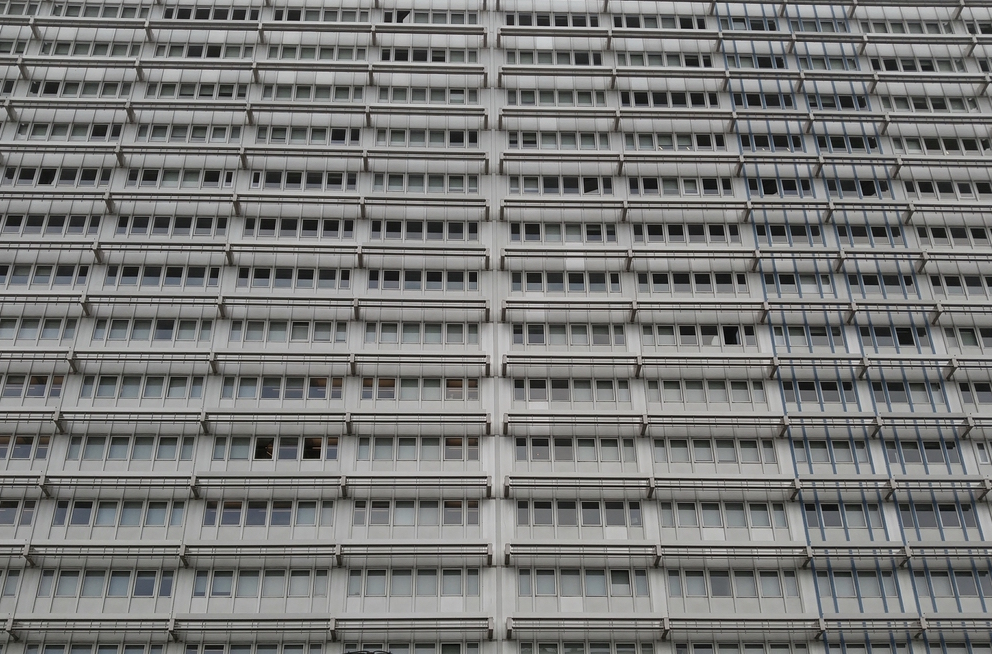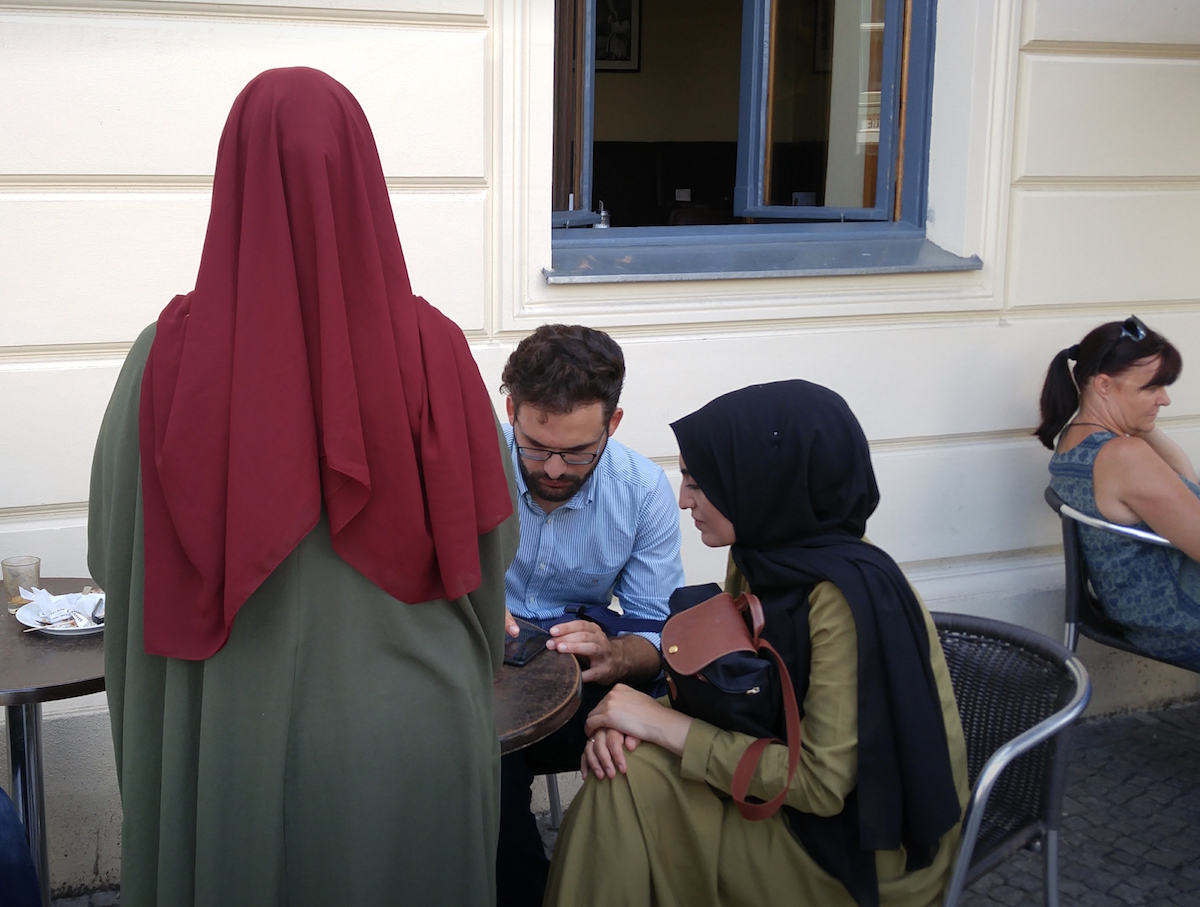When ‘Homeland’ Becomes a Politically Fraught Word
The German neighborhood of Marzahn is way out of town, near the end of the S-Bahn train line, in what used to be East Berlin. There aren’t many signs of the heady Cold War days, except the most obvious ones: endless rows of Stalinist apartment blocks. They’re plattenbau, housing constructed of prefabricated concrete slabs. From a distance, they look like the greatest set of Legos ever—they’re much more colorful than the brown-gray public housing that New Yorkers live in.
The Marzahn area was historically farmland, but in the 1970s and ’80s, these housing estates were the largest in East Germany, a mass scale showcase of socialist living. The fall of the Berlin Wall sent many residents west, and for years the Marzahn area was populated by Germans who could not or would not leave, abandoned by the new demands of capitalism. The population fell from 170,000 to about 12,000.

In 2015, the near-empty neighborhood was called on to house Muslims flooding out of the Middle East and North Africa. Chancellor Angela Merkel’s decision to bypass the orderliness of the Dublin Convention and expeditiously take in more than one million migrants (with more to come; the backlog of asylum applications is still well over 400,000) brought the challenges of assimilation to the fore of German politics. With the new additions, today every fifth person in Germany comes from an immigration background.
Initial enthusiasm gave way to fear amid rising numbers of new migrants. Violent protests hit the eastern city of Chemnitz, leading Merkel’s interior minister to call immigration “the mother of all political problems.” Populist politician Thilo Sarrazin published Deutschland schafft sich ab (“Germany Abolishes Itself”) about the end of the nation’s majority race, as more and more Muslims arrived. One conservative Christian Social Union politician announced, “Islam doesn’t belong in Germany.”
The Germans in places like Marzahn, who awoke one day to find themselves living among immigrants, reacted by registering some of the strongest support for the anti-immigration party Alternative for Germany (AfD), which helped the AfD finish third in the 2017 elections. Marzahn’s reputation for crime, especially what we might call hate crime and what Germans label “politically motivated crime,” rose.
Things are quieter now, but the area still has one of Germany’s highest unemployment rates at 20 percent. About 45 percent of families with kids use government benefits. As in Marzahn, the majority of children in 43 percent of Berlin’s elementary schools speak little or no German at home. More than 80 percent of Muslim migrants see themselves as “very religious” or “true believers.”
Walking around Marzahn, I never found trouble. Some graffiti. A lot of suspicious looks. But the stores were open and the cashiers were not hidden behind protective glass. Women in hijabs pushed baby strollers while chatting on cellphones, and men smoking shisha in the mid-afternoon returned at least obligatory nods. None wanted to talk, but none objected to me asking. They weren’t going anywhere, but they also weren’t going anywhere.
The other 88 percent of the people in the area are German.
“No, no, nobody is going to burn down the mosque,” sighed one German. “But none of us are friends with them.” Another interrupted to point out that Muslims don’t wait in line and don’t even try to speak German. They don’t work hard, he added. He had been a bricklayer. His generation had its first Christmases in the ruins of World War II. They’d seen the massive surge of Turkish guest workers, the gastarbeiters, in 1961, and complained that they still haven’t fully assimilated. Someone who might have been second- or third-generation, from Turkey, swept the floor around us and another who looked like a sibling tended bar. Nearly every German has a favorite late-night doner kebab joint run by a faux-friendly Turkish guy with a funny accent. Fewer have a Turkish best friend.
“There are always those who will take advantage of this problem, for politics,” said one German. “But no one seems to understand what we feel.” It didn’t take long for the word heimat to come up. It is often mistranslated as “homeland” or even “fatherland” by American progressives desperate to connect everything to some creeping Nazi resurgence. But a truer definition would be a place that allows someone to experience safety in the form of predictability, a place of reliability of existence. A place where you know where you are and what is around you, and what is around you supports your sense of heimat. It tells you that you are in the right place. Rooted. The opposite is feeling rootless in your supposed home, a foreigner in what was once your country.
Heimat is what this is about, creating it somehow or suffering when you don’t. It is something evolutionary, not revolutionary, not to be judged by one election or two. It’s about the longer-term, historical time scale change, the kind that took place from World War II through the Cold War through Reunification in these German lives here.
Maybe that only can happen once in a generation. But time alone doesn’t seem to be an answer either. The Turks, Germany’s largest minority group today at four million, remain largely segregated from mainstream culture. They earn lower wages than native Germans, and their children are less likely to attend university. Generations in, mostly citizens now, many still work “immigrant jobs.” As one writer put it, “We asked for workers, and human beings came instead.” Nobody had a plan for that.

A lot of things were tried. People were told they needed to change. Some refused or demanded that the other side do the changing. They are told they are racist if they don’t change, even though they feel that change is antithetical to who they are. Expecting migrants to blend in to a homogeneous society nullifies the benefits of multiculturalism. At the same time, expecting a homogeneous society to simply accept multiculturalism as a “value” ignores millennia of human nature. Anger and fear are always exploitable. The dinosaurs didn’t live forever but unmanaged they stomped a lot of mammals on the way out.
Ask Germans what their heimat will look like in five and 50 years, and everyone on both sides of the immigration debate will agree that the government will continue to ignore the problems arising from lack of integration. In search of a modern answer, one person introduced a term, societal diversity management, that’s currently missing from the polarized conversation.
Politicians decide how many immigrants come in and how fast based on their own short-term election goals. Whoever was already there and whoever just arrived are left to work it out. People stand across the street from one another, one side despairing of their rootlessness because they won’t change to assimilate the newcomers, the other facing multigenerational marginalization because they won’t adapt. They think they’re arguing over head scarves when in fact they’re arguing over the need to create a livable version of heimat.
Peter Van Buren, a 24-year State Department veteran, is the author of We Meant Well: How I Helped Lose the Battle for the Hearts and Minds of the Iraqi People and Hooper’s War: A Novel of WWII Japan.
Comments